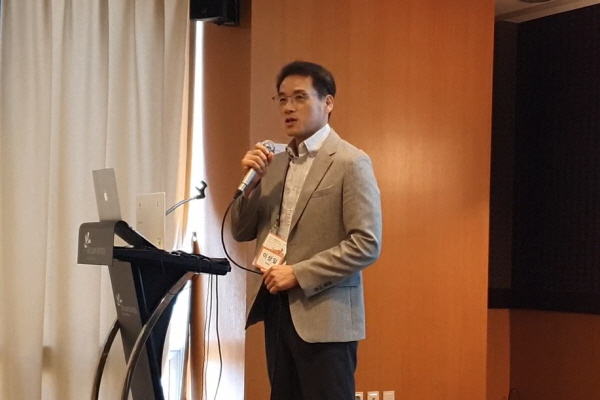한국표준과학연구원(KRISS)이 ‘2023년 가스분석측정클럽 워크숍’을 통해 글로벌 에너지 패러다임 동향을 살펴보고, 반도체용 특수가스의 종류 및 불순물 분석에 대한 기술 동향을 공유했다.
가스분석측정클럽 워크숍, 에너지패러다임 동향 주제
청정수소 상용화 위한 암모니아 크래킹 기술 등 발표
글로벌 에너지 패러다임 동향을 살펴보고, 반도체용 특수가스의 종류 및 불순물 분석에 대한 기술 동향을 공유하는 자리가 마련됐다.
한국표준과학연구원(KRISS)는 9월7일부터 8일까지 오션스위츠 제주호텔에서 ‘2023년 가스분석측정클럽 워크숍’ 개최했다.

▲이상일 한국표준과학연구원 화학바이오표준본부 본부장이 인사말을 하고 있다.
이번 워크숍에서는 ‘에너지 패러다임 동향’을 주제로 그린 암모니아 및 액체수소, 수소차 등 청정에너지 관련 동향 및 반도체 세션으로 반도체용 특수가스 순도 분석 방법을 공유했다.
또한 산업용가스제조사, 한국특수가스산업협회, 한국고압가스공업협동조합, 한국의료용고압가스협회 소개 및 발표하는 자리도 마련됐다.
기후변화와 관련해서는 탄소배출이 없는 청정수소가 연료로 부각되고 있다.
현재까지 수소는 각 지역별로 생산해 사용돼 왔으나 향후 국가간 무역이 활발하게 이뤄질 것으로 전망되고 있으며, 이에 따라 각 국가별로 마련된 청정주소의 기준 준수가 무엇보다 중요할 것으로 예상된다.
우리나라의 청정수소 인증 기준안은 4㎏CO2/㎏H2이나 일본, 유럽의 경우 우리나라보다 강화된 기준을 적용하고 있어, 향후 국제 거래시 주의가 요구되고 있다.
딜로이트의 전망에 따르면 2050년 전체 에너지소비의 약 10%를 청정수소가 차지할 것으로 전망되고 있으나 2021년까지 수소 생산의 95% 이상이 그레이 수소로 청정수소 생산을 위한 인프라 및 기술 개발에 상당한 투자가 이뤄져야 할 것으로 분석된다.
향후 청정수소로는 암모니아가 큰 역할을 할 것으로 전망되는데, 이는 기존의 수소 생산 방법인 SMR(Steam Methane Reforming) 공정과 암모니아 크래킹 공정이 공정 구성 및 반응온도 등에서 차이가 있으나 운영방식 및 운전 노하우 등에서 거의 유사하기 때문이다.
또한 암모니아 크래킹으로 생산되는 수소는 SMR 공정에 비해 2배이상인데, CO2 배출이 없는 것도 장점이다.
특히 현재 암모니아 크래킹은 상용화 기술이 확보된 상태로 알려져 경제성이 떨어지는 수전해에 비해 더 빨리 상용화가 가능할 것으로 기대된다.
이외에도 액화수소 및 수소차에 대한 정보가 공유됐다.
반도체용 특수가스 세션에서는 반도체용 특수가스 불순물 분석법 및 BSGS 기술 동향, GC를 이용한 반도체용 특수가스의 불순물 분석기술개발 방법론이 발표됐다.
고순도 특수가스의 경우 국내 제조뿐 아니라 일본산, 중국산 등 해외에서 제조돼 유통되는 경우도 많기 때문에 공정에 투입되는 특수가스의 일관성을 유지하기 위해서는 정확한 순도분석이 필수적으로 요구된다.
이에 반도체용 특수가스 공급사는 반도체 생산 공장의 사회 원거리에서 고위험성 가스를 초고유량으로 안정적으로 저장, 공급할 수 있는 초고순도 특수가스 공급장치를 갖추고 있으며, 온라인 불순물 모니터링 분석시스템을 이용한 입고, 출하 검사를 하고 있다.
또한 비상시 자동 차단 및 배기가 되도록 안전장치가 구성된 가스 공급시스템이 필요로 하며, 일반적으로 ISO 가스 트레일러와 대유량 가스판넬 연결부가 설치되는 건물과 이를 구동에 필요한 지원설비등이 패키지로 건설된다.
이번 세미나에서는 지앤엘의 인민교 전무와 오상협 표준연 박사가 △SiH4 △NH3 △N2O △NF3 △CO2 △CF4 △HCL △H2 △N2 △HF △CHF3 △CH2F2 △C4F8 등의 가스 분석장비 및 분석방법을 공유했다.
한편 한국표준과학연구원 가스분석표준그룹은 산업용 고압가스, 독성가스, 온실가스, 미세먼지 및 가스동위원소비 등과 관련된 측정표준을 확립하고, 인증표준물질을 개발해 측정 소급성을 보급하며 국내외 규제물질에 대한 측정 솔루션을 제공하고 있다.
주요 연구성과로는 △반도체 가스소재 순도분석 기반 구축 △2차 생성 질소산화물 측정기반 구축 △미니실린더 자동 측정장치 개발 △연료전지용 수소 순도분석 기반 구축 등이 있으며, 반도체용 가스 소재의 국가 측정체계 기반 구축에도 적극 나서고 있다.
.jpg)
▲2023년 가스분석측정클럽 워크숍 참석자들이 기념촬영을 하고 있다.

.jpg)